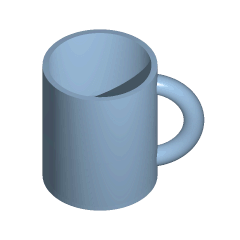
Back تصاكل Arabic Homeomorfluq Azerbaijani Гомеамарфізм Byelorussian Хомеоморфизъм Bulgarian সম-অবিচ্ছিন্ন চিত্রণ Bengali/Bangla Homeomorfisme Catalan Homeomorfismo CBK-ZAM Omeumurfismu Corsican Homeomorfismus Czech Гомеоморфизм CV

In mathematics and more specifically in topology, a homeomorphism (from Greek roots meaning "similar shape", named by Henri Poincaré),[2][3] also called topological isomorphism, or bicontinuous function, is a bijective and continuous function between topological spaces that has a continuous inverse function. Homeomorphisms are the isomorphisms in the category of topological spaces—that is, they are the mappings that preserve all the topological properties of a given space. Two spaces with a homeomorphism between them are called homeomorphic, and from a topological viewpoint they are the same.
Very roughly speaking, a topological space is a geometric object, and a homeomorphism results from a continuous deformation of the object into a new shape. Thus, a square and a circle are homeomorphic to each other, but a sphere and a torus are not. However, this description can be misleading. Some continuous deformations do not result into homeomorphisms, such as the deformation of a line into a point. Some homeomorphisms do not result from continuous deformations, such as the homeomorphism between a trefoil knot and a circle. Homotopy and isotopy are precise definitions for the informal concept of continuous deformation.
- ^ Hubbard, John H.; West, Beverly H. (1995). Differential Equations: A Dynamical Systems Approach. Part II: Higher-Dimensional Systems. Texts in Applied Mathematics. Vol. 18. Springer. p. 204. ISBN 978-0-387-94377-0.
- ^ Poincaré, H. (1895). Analysis Situs. Journal de l'Ecole polytechnique. Gauthier-Villars. OCLC 715734142. Archived from the original on 11 June 2016. Retrieved 29 April 2018.
Poincaré, Henri (2010). Papers on Topology: Analysis Situs and Its Five Supplements. Translated by Stillwell, John. American Mathematical Society. ISBN 978-0-8218-5234-7. - ^ Gamelin, T. W.; Greene, R. E. (1999). Introduction to Topology (2nd ed.). Dover. p. 67. ISBN 978-0-486-40680-0.